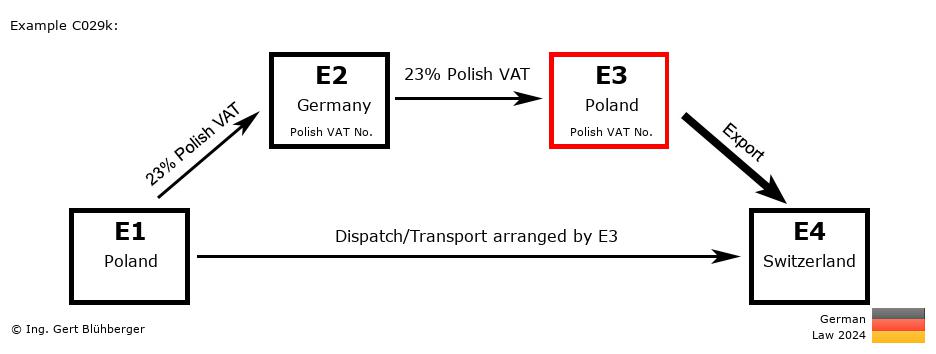Facts:
A Swiss entrepreneur E4 (= last purchaser) orders a machine from his Polish supplier E3 (=2nd purchaser). The latter in turn orders the machine from the German wholesaler E2 (=1st purchaser). Since the wholesaler E2 does not have the machine in stock, he orders it from the Polish manufacturer E1 (= first supplier).
The Polish entrepreneur E3 instructs his forwarder with the pickup of the machine from the Polish manufacturer E1 and subsequent delivery to the Swiss entrepreneur E4. The Polish entrepreneur E3 (=intermediary operator) acts with his Polish VAT identification number and he communicates it to the German wholesaler E2 in writing in the order document at the latest until the beginning of the shipment. Brief description of the chain transaction:
- Registration obligations:
- The German entrepreneur E2 has to obtain a VAT registration in the country of departure (Poland).
- "Supply 1" from E1 (Poland) to E2 (Germany)
- Transaction without transport/dispatch assignment (§ 3 (7) UStG)
- Taxable supply in Poland (E1)
- "Supply 2" from E2 (Germany) to E3 (Poland)
- Transaction without transport/dispatch assignment (§ 3 (7) UStG)
- Taxable supply in Poland (E1)
- "Supply 3" from E3 (Poland) to E4 (Switzerland)
- Special feature of this chain transaction
- Since the Polish entrepreneur E3 acts with his Polish VAT identification number towards the German entrepreneur E2, the provision of the § 3 (6a) UStG applies. As a result, the assignment of dispatch or transport shifts to the supply between E3 and E4 and from a German perspective the Polish entrepreneur E3 does not have to register in the destination country Switzerland.
Detailed description from the perspective of the individual entrepreneurs: From the perspective of the 1st supplier E1 (from Poland): From the perspective of the 1st supplier E1 (from Poland):
Outgoing Invoice:
- Invoicing:
This supply is taxable in Poland (E1). The invoice must therefore be issued with 23 % Polish VAT, stating the own (Polish) VAT identification number.
- VAT Return:
Declaration of the sales transaction as a taxable (domestic) supply.
 From the perspective of the 1st purchaser E2 (from Germany): From the perspective of the 1st purchaser E2 (from Germany):
Registration obligations:- The German entrepreneur E2 has to obtain a VAT registration in the country of departure (Poland) and act with his Polish VAT identification number towards E1 and E3. The entries listed below are consequently to be included in the Polish VAT return.
Incoming Invoice:
- VAT return (at the Polish Tax Office):
The Polish VAT contained in the incoming invoice can be deducted as input tax and must be included in the VAT return accordingly.
Outgoing Invoice:
- Invoicing:
This supply is taxable in Poland (E1). The invoice must therefore be issued with 23 % Polish VAT and specification of the own Polish VAT identification number.
- VAT Return (at the Polish Tax Office):
Declaration of the sales transaction as a taxable (domestic) supply and payment of the VAT from this supply to the Polish Tax Office.
 From the perspective of the 2nd purchaser E3 (from Poland): From the perspective of the 2nd purchaser E3 (from Poland):
Incoming Invoice:
- VAT return:
The Polish VAT contained in the incoming invoice can be deducted as input tax and must be included in the VAT return accordingly.
Outgoing Invoice:
- Invoicing:
Invoice without VAT with reference to the tax exemption (tax-exempt export supply) pursuant to § 4 (1)(a) UStG in conjunction with § 6 UStG (or alternatively with reference to Article 146 of the Directive 2006/112/EC).
- VAT Return:
Declaration of the sales transaction as a tax-exempt export supply.
 From the perspective of the last purchaser E4 (from Switzerland): From the perspective of the last purchaser E4 (from Switzerland):
Incoming Invoice:
- VAT return:
Whether the import VAT is to be included in the VAT return and if an entitlement to deduct VAT obtains is governed by the legal provisions of the third country and is not analyzed in more detail here, since Switzerland is only an example of many possible third countries.
Notes to the chain transaction:
- According to the standard conditions in the chain transaction calculator, the export declaration is made by the entrepreneur who arranges the transport. In this example, this would lead to the unusual case that E3 issues an export invoice (without VAT) to E4, but has to pay import VAT in the third country in the course of the export declaration. The evaluation of this example is therefore based on the assumption that the export declaration is made for E4.
- The above detailed descriptions from the perspective of entrepreneurs E1, E2 and E3 represent only an indication of how the tax assessment would be if the German laws were to apply in Poland. National deviations from the German legislation were also not taken into account in the chain transaction sketch and the brief description!
- In addition to the entries in the VAT return as stated above, the German entrepreneur E2 must record in the German VAT return in line 36/code 45 supplies that are not taxable in Germany whose place of supply is outside Germany and which would be taxable if they would be carried out within the country.
- You can find the German version in the reihengeschaeftrechner.de.
Please note the Terms of Use and the Disclaimer of Liability. |

